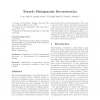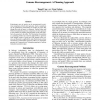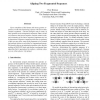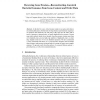137
Voted
BMCBI
2010
15 years 1 months ago
2010
Background: Overlapping genes (OGs) are defined as adjacent genes whose coding sequences overlap partially or entirely. In fact, they are ubiquitous in microbial genomes and more ...
106
click to vote
BIOCOMP
2007
15 years 2 months ago
2007
Reconstructing phylogenies is one of the primary objectives in evolution studies. Efficient software to reconstruct phylogenies based on isolated genes has existed for decades, ye...
AAAI
2010
15 years 2 months ago
2010
Evolutionary trees of species can be reconstructed by pairwise comparison of their entire genomes. Such a comparison can be quantified by determining the number of events that cha...
146
click to vote
STOC
1995
ACM
15 years 4 months ago
1995
ACM
Genomes frequently evolve by reversals (i, j) that transform a gene order 1 . . . iiϩ1 . . . jϪ1j . . . n into 1 . . . ijϪ1 . . . iϩ1j . . ....
CSB
2004
IEEE
15 years 4 months ago
2004
IEEE
Shannon information in the genomes of all completely sequenced prokaryotes and eukaryotes are measured in word lengths of two to ten letters. It is found that in a scale-dependent...
112
click to vote
BIBE
2004
IEEE
15 years 4 months ago
2004
IEEE
Phylogenetic reconstruction from gene-order data has attracted attention from both biologists and computer scientists over the last few years. So far, our software suite GRAPPA is...
113
click to vote
RECOMB
1997
Springer
15 years 5 months ago
1997
Springer
The paper studies the computational complexity and approximation algorithms for a new evolutionary distance between multi-chromosomal genomes introduced recently by Ferretti, Nade...
86
Voted
IPPS
2002
IEEE
15 years 6 months ago
2002
IEEE
Upon completion of the human and mouse genome sequences, world-wide sequencing capacity will turn to other complex organisms. Current strategies call for many of these genomes to ...
111
click to vote
WABI
2004
Springer
2004
Springer
Reversing Gene Erosion - Reconstructing Ancestral Bacterial Genomes from Gene-Content and Order Data
15 years 6 months ago
In the last few years, it has become routine to use gene-order data to reconstruct phylogenies, both in terms of edge distances (parsimonious sequences of operations that transform...
125
click to vote
CPM
2004
Springer
15 years 6 months ago
2004
Springer
A popular approach in comparative genomics is to locate groups or clusters of orthologous genes in multiple genomes and to postulate functional association between the genes contai...





